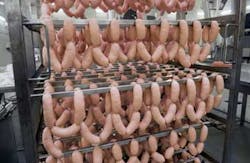U.S. pork exports inched down 1% year-on-year in June, with 23.8% of pork produced in the country being shipped abroad, The Pig Site reports.
The decline came in spite of a substantial increase in exports to Mexico, the second biggest foreign market for U.S. pork producers. June pork exports to Mexico jumped by 24%. Sales to Japan, the top export destination for U.S. pork, grew by 7%. The negative year-on-year comparison was the result of a slump in exports to Russia.
Imports, on the other hand, increased by 5.6% on the year, the primary reason being more Canadian pork entering the U.S. market. Overall, imports equated to 4% of U.S. pork production in June.
The picture was different when it came to live hog imports, which fell by 15% in June. The decline was even greater for feeder pig imports (18%) but import of slaughter hogs edged up by 0.7%.
According to calculations by Ron Plain, a livestock economist at the University of Missouri-Columbia, domestic meat demand in June rose by 1.7% on the year. The only category to experience a decline was turkey, where demand fell by 4.5%. Pork demand grew by 5.2%, beef demand rose by 1.2% and chicken demand edged up 0.7%.
RELATED: Canada's meat and poultry industry starts to recover
The Pig Site also reported that the PED (porcine epidemic diarrhea) virus had reached 434 farms across 16 states by 28 July, as estimated by the American Association of Swine Veterinarians. Iowa is the hardest hit state, accounting for 35.5% of the affected farms. Oklahoma is home to 23.5%, while Minnesota has 9% of them. One case of the virus has also been confirmed in Missouri. The peak of new infections seems to have been in the early days of June.
PED is a devastating swine disease known since at least the 1970s. However, this is the first time it has crossed into the United States and consumers are already feeling the impact through higher bacon prices.
Dr. Bruce Brodersen, assistant professor at the University of Nebraska-Lincoln's Veterinary Diagnostic Center, noted that the U.S. swine population was highly susceptible to the virus due to its lack of previous exposure. The complete absence of immunity makes the disease outbreaks very severe and the pig mortality rate is devastating, he added.
The number of cases confirmed in the lab by the U.S. Department of Agriculture stands at just 400 or so but PED is estimated to have already killed hundreds of thousands of pigs. This has driven pork price futures to historic levels: hundredweights of pork recently traded for about $105 on the Chicago Mercantile Exchange. According to the USDA, the figure stood at $78 in March. The increase has been particularly speedy for pork bellies, with Fox Business News reporting a 5% rise over five days. As a result, the wholesale price of one hundred pounds of fresh pork belly went over $189. In urban supermarkets, a pound of pork was selling for $4.92 last month, which translates into a year-on-year increase of 14% and represents the highest amount recorded to date, according to estimates from the Bureau of Labor Statistics.



